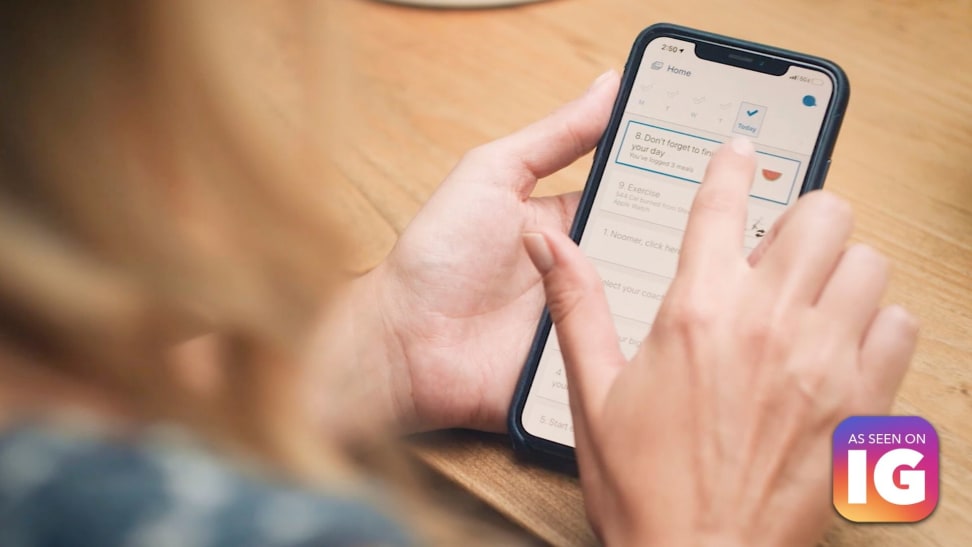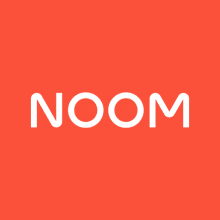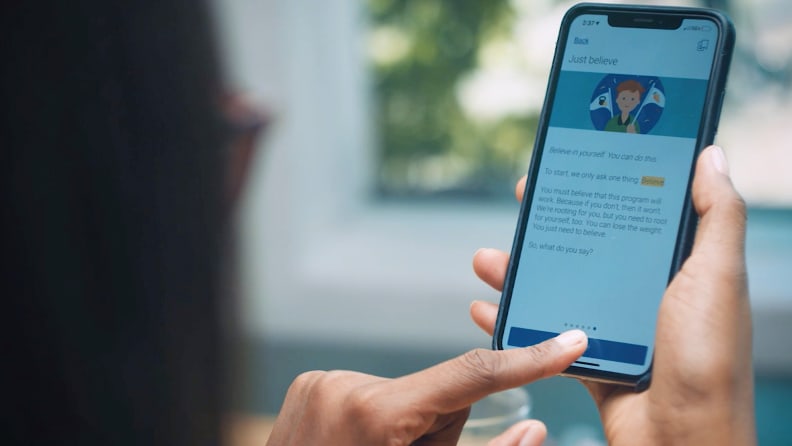I tried the weight-loss app Noom for three months—here's what happened
Is Noom a miracle? No, but it feels like a sustainable way to create healthier habits.
 Credit:
Noom / Reviewed / Naidin Concul-Ticas
Credit:
Noom / Reviewed / Naidin Concul-Ticas
Products are chosen independently by our editors. Purchases made through our links may earn us a commission.
There’s a lot of mystery around Noom—starting with “what even is it?” The company’s Instagram feed is full of mouthwatering pictures of healthy food, nutrition infographics, and testimonials. But what exactly does Noom offer? You get a feeling it’s about weight loss, but there are no before-and-after shots, no overly large pants that no longer fit, and not many enthusiastic testimonials. What is this thing?
I wasn’t sure what to expect when I volunteered to test Noom—but what I found is an easy-to-follow behavior-management program with a bonus weight-loss component. For three months I logged my weight and food intake using Noom, and I lost 20 pounds in that time. Is it a miracle? No, but it feels like something more substantial: A sustainable way to create healthier habits.
(Editor's Note: We originally wrote this review in January 2020. To see how our writer fared a year after writing this review and her experiences rejoining Noom read her updated Noom review. Spoiler alert: She kept the weight off and lost an additional 12 pounds trying it again.)

Lose weight for good with the help of Noom.
What is Noom?
Put simply: Noom is an app on your phone that helps you track your weight, monitor what you eat, and connect with like-minded people in your same situation.
Noom is not a fad diet or an overly-regimented elimination program, nor does it offer radical nutrition advice or mindless meal-plan delivery. Its underlying nutritional philosophy is similar to the famous koan from nutritionist Michael Pollan: Eat food, not too much, mostly plants.
What Noom does well is create an interactive diary that helps you stick to that method. Ultimately, you make the healthier choices, Noom just creates a framework to make those choices easier. Noom treats you like an adult, even if you’re a stressed-out and time-crunched one.
How does Noom work?

Noom is easy to integrate into your everyday routine.
In order to use Noom, you need to have a smartphone, email address or social media account, and a credit card. You’ll first sign up for Noom on their website, then download the app to your phone. (It’s available on the App Store for iOS devices or Google Play store for Android devices.)
When you sign up and create an account, the app will make you take a short personality quiz. (It’s not clear what the quiz assesses; I suspect your answers help sort you into your support group or adjust the language that you read in your daily notes.)
Once you have your account set up, using Noom is as easy as reading an email and typing a reply. Every day the app refreshes with about eight tasks the app asks you to complete. Most of the tasks are short articles to read, usually about nutrition, but often about psychological approaches—mindfulness, for instance—that reframe your outlook on dieting, or even life. Others are quick tests that quiz you on the articles (no doubt a way to reinforce the information Noom’s trying to teach).
Noom has raised a lot of money from Silicon Valley venture capitalists, and they’ve clearly spent a fair chunk of those funds on a solid team of user interface designers and copywriters. The articles are written in a very approachable manner, though they sometimes flirt with being too flippant. (There’s a lot of talk about “#NoomNerds”—hashtag included—for instance.)
The thing I appreciate most is how transparent Noom is with its psychological approaches. The app presents information in a way that I’d charitably describe as artful (or manipulative, if you prefer), but then points out how and why those mechanisms work to reframe your thinking about food, weight, fear, or overall life changes.
Noom admits it when you sign up: “We have a ton of psychological tricks up our sleeves to change your personal triggers and routines.” That being said, you can easily get away with ignoring the articles and quizzes if the language is too off-putting—although there’s something I find satisfying about checking off all of the daily tasks, in an Inbox Zero type of way.
Two compulsory to-dos make up the heart of Noom: daily weigh-ins and food logging. For the first, most people will need to open up the app and manually enter in their number from their bathroom scale, though some smart scales can connect automatically. After a while, it became a routine part of my morning. The hardest part, really, is facing your own ego and stepping on the scale in the first place.
The most interactive aspect of Noom is the food logging. At heart, Noom is a calorie-counting program, and it gives you a daily goal for calorie consumption that you aim to hit every day. Unfortunately, food logging is still a manual procedure, but Noom’s interface makes it less of a pain than similar programs I’ve used. (The free version of MyFitnessPal has a similar mechanism, but I found using Noom to be smoother and less cumbersome.) It has a collection of food already in its database, and an easy way to scan the barcode on a nutrition label to retrieve that food’s information. You can also add additional food items or meals to its database manually. Once you add an item, you’ll be able to retrieve it in the future, which can be very helpful if you end up cooking the same meals often.
What is the Noom diet?

Noom makes logging food quick and easy.
Noom classifies foods into three different groups: Green, or foods that you should encourage including in your diet; Yellow, or foods that are mostly okay, but should be consumed in smaller amounts; and Red, or foods that you should limit in your daily life.
The three classifications are based on how much caloric density is in each food. Green food includes low-caloric-density foods such as vegetables, fruits, and other foods with high water content. Red foods include nuts, cheese, and other items that contain a lot of calories in a small amount. The idea here is that you can simply eat a larger amount of foods with less calories per ounce (say, 100 calories of spinach, or an entire pound of the salad greens) than the same amount of higher-caloric-density foods (like 100 calories of Skittles, or a measly 25 of the tiny candies).
Because the lower-caloric-density foods tend to contain more water and fiber, it’s likely that those foods will also keep you sated for longer. If you’re less hungry, then you’ll be less likely to overindulge.
These classifications are more guidelines than rules; If you go over your Red food allotment for the day but stay within your calorie range—or even exceed your daily calorie count in total—there are no repercussions beyond seeing the bar chart exceed your target ceiling.
How much does Noom cost?
Depending on which subscription you select, you get either a seven- or 14-day free trial when you start Noom. After that, you may purchase an auto-renewing subscription for however many months you like—the longer your subscription, the more you save. (You can check out Noom’s pricing plan on its website here.)
Plans start at $70 a month. A six-month subscription costs $179, equivalent to about $20 a month, and an annual plan costs $209, about $17 a month. You do need to pay for the plan before accessing your free trial.
You also can’t prorate the program: If you cancel during week 3, it will cut you off immediately and you’ll be out that $150. Therefore, setting a calendar reminder to cancel—either at the end of the two weeks or at the end of six months—is crucial if that’s your intention. (To its credit, the emailed receipt you receive when you sign up for Noom is pretty helpful about this timeframe: It spells out exactly when you’ll need to cancel and when you’ll be charged.)
It’s a steep up-front price, especially compared to food-logging apps like MyFitnessPal, which has a free version. When you look at it from a month-to-month budgeting perspective, the basic Noom program costs more than six months on the basic tier of WW, formerly Weight Watchers, but substantially less than six months on the coach-supported WW plan (more on how Noom compares to WW below).
What do you get with Noom after the free trial?
During the first two weeks, you have access to most of the Noom experience—just not all of it. The free trial includes the food logging, weight tracking, and helpful tips. If you decide that the program isn’t for you, you can cancel your trial within the first two weeks.
The biggest change after the free trial is the introduction of a support specialist and group chat with other Noom users who started around the same time as you. The support specialist seems useful in concept, though I have yet to ask her a question. The group chat is hit-or-miss, and I suspect it depends on the makeup of the group you’re assigned to. Over the weeks I’ve been on Noom, there have been moments when the chatroom is active and lots of people participating, and there are times where it’s mostly crickets.
What are the downsides to Noom?

Noom isn’t perfect. As mentioned before, the articles and quizzes have a particular language to them that some people may find off-putting. While I think Noom falls on the right side of the line as a whole, the occasional message, quiz answer, or button language made me roll my eyes. They work hard to avoid being condescending, but you can see all that effort at work.
Food logging is inherently annoying and, while Noom’s interface is a better-than-average one, it’s always a pain when the database doesn’t include the food you want to log. It’s frustrating to scan a UPC code and get a message asking you to enter that food manually, which usually happened whenever I bought an item that Trader Joe’s just launched. Entering in meals from non-chain restaurants is also bothersome, and the best course of action is to reverse-engineer your meal and guesstimate the portions of each ingredient in your serving (though this happens on any food-logging app). Or, as I’ve done, pick a similar-looking choice already entered in the database, which is why I logged a meal at a make-your-own taco bar as “street tacos.”
It’s also impossible to edit a custom meal once you’ve added it, which drives me mad. The one help message I’ve sent to Noom asked how I could fix a typo in my custom recipe, and I have yet to receive a reply. So, on nights I make it, I add “puttanesca dauce” to my food log and wonder if there’s any kind of diet that can fix fat fingers.
How does Noom compare to other diet plans?
It's impossible not to compare Noom to the similar WW, which also offers guidelines that designate foods into groups. (I haven't tried WW myself, but I asked a coworker who has.) In WW's case, it uses points rather than colors; zero-point foods being akin to Noom's "green" food group.
With WW, there's some mental math involved counting points on the fly—with its app keeping official track when you log food—though it similarly doesn't shame you for overdoing your overall point count. WW also offers differently priced plans depending on how much support you prefer, which varies from digital-only logging to personal phone calls.
You can also get basic food logging on apps like MyFitnessPal and Fitbit. With the free options, you have access to food databases and a way to track your intake, but these don't provide the programmed guidance of Noom. Paid programs are available from those apps and others that include more support and coaching, but I haven't tested those.
But it's Noom's programmed guidance—all those articles and quizzes and, yes, even that #NoomNerd eye-rolling terminology—that feels like the key differentiator. Noom's emphasis on behavior management makes this program seem, well, mentally healthier than anything else I've tried. There's no rigid rules to memorize and the calorie counting seems more informative than competitive. (You can't, for instance, hoard calories one day so you can blow your budget the next.) This is the first diet I've tried where I haven't felt like a hungry, raving lunatic at some point during the process.
Does Noom work?
Noom’s strong points are its sensible approach to nutrition and straightforward logging. You don’t need an app to do that. A calculator and paper notebook would suffice. But Noom makes it a lot easier. Seeing the weight graph trend downwards is rewarding, and having an easy-to-use interface to log your meals is great for keeping track of your intake.
I also really appreciated how private Noom let me be during this process. There were no forbidden foods, so I didn't have to explain to anyone that I was on a special diet when I dined with them. When we were done with our meals, I just typed a few things on my phone and that was it. There were no meetings to attend, so I didn't have to worry about coordinating my schedule with whatever meetings were available. I could read—or ignore—the content they provided at the time that was most convenient for me, whether that was on the subway, in line at CVS, or in my kitchen making a meal. My outward behavior didn't change, beyond preparing more meals at home instead of eating takeout lunches. (No one in the office even knew I was testing Noom, aside from my editor.) In essence, I feel like I lost 20 pounds in 100 days just by staring at my phone.
Is Noom worth it?
Weight loss apps are a lot like dating apps: The most successful customers are also the ones who ultimately no longer need it. The difference, of course, is that instead of ending up in a relationship with another person, Noom forces you to work hard on establishing a better (and hopefully long-term) relationship with food, and with yourself.
